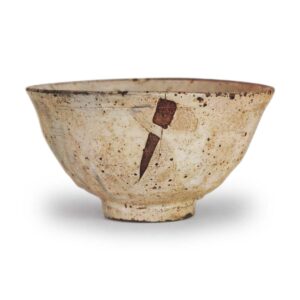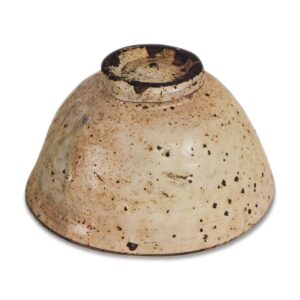

Dai-Meibutsu
Height: 8.05 – 8.25 cm
Diameter: 14.7 – 15.4 cm
Outer diameter of foot: 5.55 – 5.7 cm
Height of foot: 1.1 – 1.4 cm
It was owned by Motoyoshi Nagayoshi, so it is known as the Mino ware of the Mino family, and is known as a famous bowl of the Mino ware, along with the Kaga Maeda family’s Soshi and the Unshu Matsudaira family’s Funabiki.
The clay is a rough, iron-rich clay, and both the inside and outside are covered in a white slip. The characteristic of kohiki is that it is made by covering red clay with a white slip, and the name kohiki or kohuki comes from this. The entire piece is covered in a transparent white glaze on top of the white slip, but the glaze is not applied in a lump, but rather poured on with a ladle, which is another characteristic of kohiki. The firing is slightly reducing, and the areas with a thick glaze have a slight bluish tinge, while the very thinly glazed areas have no craquelure, but the thicker areas have rough craquelure. The shape is a bowl with a slightly sloping rim, and a low, stable foot supports it. The bottom is unglazed, and there are five brownish-black marks where tea has stained the surface. The underside of the bottom is also covered in white slip, and the glaze stands up in the middle in a kind of helmet shape. The bowl is thinly made, and feels light and elegant in the hand. There is a part of the body that is not covered in glaze, called a “fire space”.
In some cases, the part where the white slip was left unpainted has turned a mouse color, but in the case of Miyoshi, although the white slip was applied, when the glaze was applied with a ladle while turning the bowl, a part of the body was left unpainted, and this became dirty with tea stains and turned blackish brown. After the glaze was applied, the tea bowl was turned on its side, so the glaze dripped down the side and onto the hearth, dividing the hearth into two levels. This is a scene that was created unintentionally, but powder-coated tea bowls with hearths are especially prized by tea masters. One thing to note is that in the case of Miyoshi, the hearth is shaped like a sliding door, slanting from the top right to the bottom left. Normally, the fire-space is formed in the shape of a sliding door from the top left to the bottom right, and this is how you would hold the tea bowl in your left hand and the ladle in your right hand. In the case of Miyoshi, however, the tea bowl is held in the right hand and the ladle in the left hand, which is to say, it is a rare example of a potter who was left-handed applying the glaze. The same is true of the funori ware that was passed down in the former Unshu Matsudaira family and is now in the Hatakeyama Memorial Museum. It has a fusuma-style hema that runs from the top right to the bottom left, and I think that it was probably made by the same left-handed potter, both in terms of its shape and the way it was made.
It is said that the powdered porcelain was made in Jangheung, Jeollanam-do, and many pieces have been excavated from tombs in the Jangheung and Miryang areas, but there are few surviving examples. There is also an old tea book that says, “Powdered tea bowls are rare, and there are two types: the rice-cooker Goryeo tea bowls of the Geishu family and the Miyoshi powdered tea bowls. The Taisho Meiki Kan (A Guide to Famous Tea Bowl of the Taisho Period) lists five pieces: the Matsudaira family’s Kohiki, the Miyoshi Kohiki, the Gifu Asano family’s Kohiki, the Nomura family’s Kohiki, and the Ueno family’s Zansetsu. Of these, the Miyoshi Kohiki is the most famous tea bowl from ancient times. The Miyoshi Kohiki was originally owned by Miyoshi Nagayoshi, and after his death it became the property of Hideyoshi, and then it was owned by Kanamori Sowa, and then by Mitsui Haraemon. In December 1855, along with the Kitano Katsuzuki, Niji Tenmoku and Kora Tsutsubana-iri, it was sold to Lord Sakai Tadayoshi by the Mitsui family for 4,854 ryou, but in 1923 it was sold back to the original Mitsui family at a high price of 76,200 yen at a Wakasu Sakai family auction. Inner box, paulownia wood, by Sowa Kanamori, with two accompanying notes.



